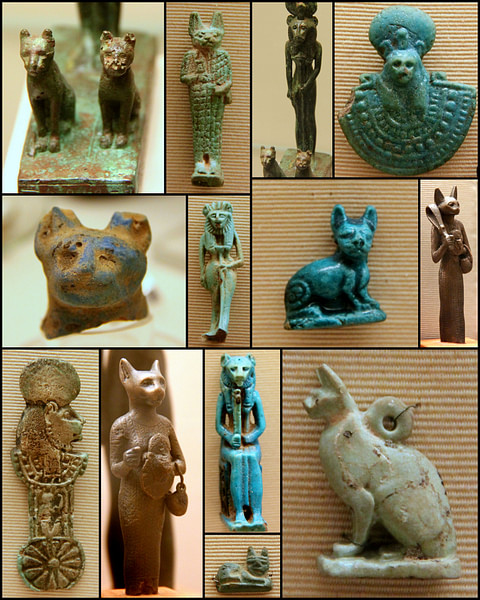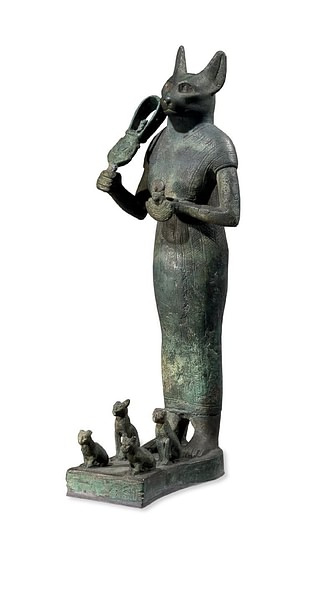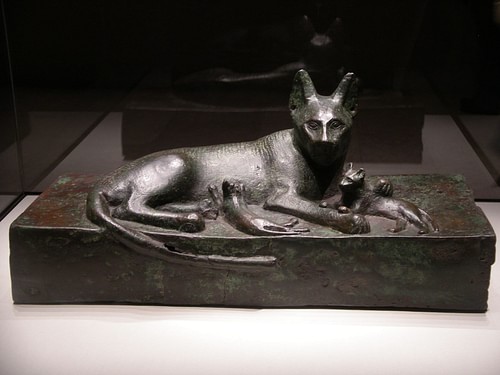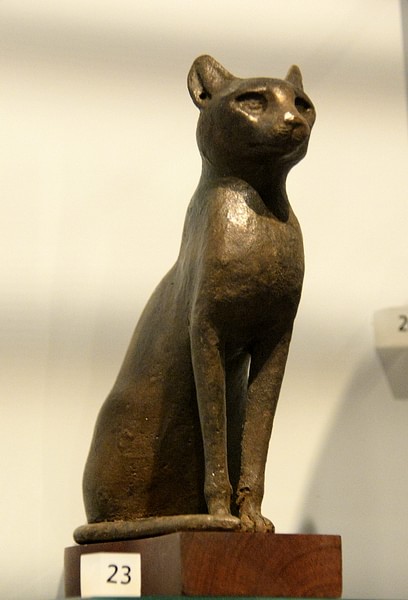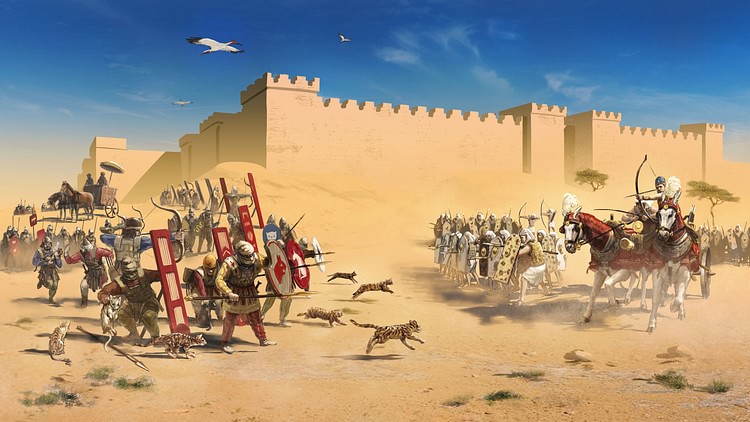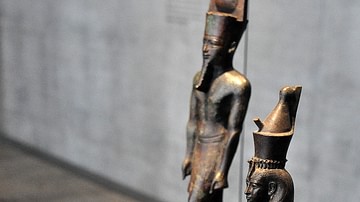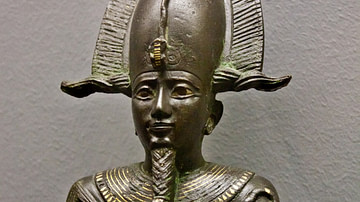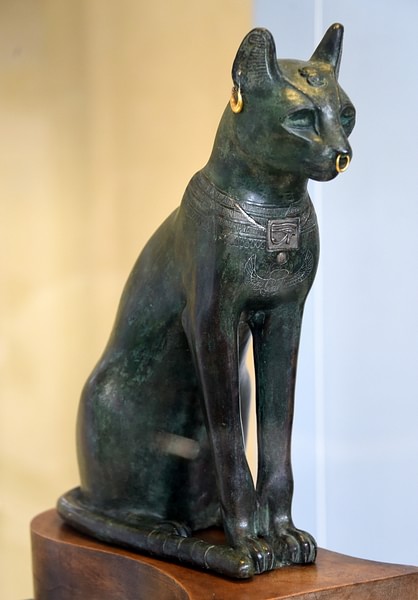
Bastet is the Egyptian goddess of the home, domesticity, women's secrets, cats, fertility, and childbirth. She protected the home from evil spirits and disease, especially diseases associated with women and children. As with many deities in Egyptian religion, she also played a role in the afterlife.
She is sometimes depicted as a guide and helper to the dead although this was not one of her primary duties. She was the daughter of the sun god Ra and is associated with the concept of the Eye of Ra (the all-seeing eye) and the Distant Goddess (a female deity who leaves Ra and returns to bring transfromation). Bastet was one of the most popular deities of ancient Egypt as she was the protector of everyone's home and family.
Meaning of Bastet's Name
Her name was originally B'sst which became Ubaste, then Bast, then Bastet; the meaning of this name is not known or, at least, not universally agreed upon. Geraldine Pinch claims that "her name probably means She of the Ointment Jar" as she was associated with protection and protective ointments (115). The Greeks associated her closely with their goddess Artemis and believed that, as Artemis had a twin brother (Apollo) so should Bast. They associated Apollo with Horus, the son of Isis (Heru-sa-Aset) and so called the goddess known as Bast ba'Aset (Soul of Isis) which would be the literal translation of her name with the addition of the second 'T' to denote the feminine (Aset being among the Egyptian names for Isis).
Bastet, however, was also sometimes linked with the god of perfume and sweet smells, Nefertum, who was thought to be her son and this further links the meaning of her name to the ointment jar. The most obvious understanding would be that, originally, the name meant something like She of the Ointment Jar (Ubaste) and the Greeks changed the meaning to Soul of Isis as they associated her with the most popular goddess in Egypt. Even so, scholars have come to no agreement on the meaning of her name.
Associations
Bastet was extremely popular throughout Egypt with both men and women from the Second Dynasty of Egypt (c. 2890 - c. 2670 BCE) onward with her cult centered at the city of Bubastis from at least the 5th century BCE. She was first represented as a woman with the head of a lioness and closely associated with the goddess Sekhmet but, as that deity's iconography depicted her as increasingly aggressive, Bastet's images softened over time to present more of a daily companion and helper than her earlier forms as savage avenger. Scholar Geraldine Pinch writes:
From the Pyramid Texts onward, Bastet has a double aspect of nurturing mother and terrifying avenger. It is the demonic aspect that mainly features in the Coffin Texts and the Book of the Dead and in medical spells. The "slaughterers of Bastet" were said to inflict plague and other disasters on humanity. One spell advises pretending to be the 'son of Bastet' in order to avoid catching the plague. (115)
Although she was greatly venerated, she was equally feared as two of her titles demonstrate: The Lady of Dread and The Lady of Slaughter. She is associated with both Mau, the divine cat who is an aspect of Ra, and with Mafdet, goddess of justice and the first feline deity in Egyptian history.
Both Bastet and Sekhmet took their early forms as feline defenders of the innocent, avengers of the wronged, from Mafdet. This association was carried on in depictions of Bastet's son Maahes, protector of the innocent, who is shown as a lion-headed man carrying a long knife or as a lion.
In Bastet's association with Mau, she is sometimes seen destroying the enemy of Ra, Apophis, by slicing off his head with a knife in her paw; an image Mau is best known by. In time, as Bastet became more of a familial companion, she lost all trace of her lionine form and was regularly depicted as a house cat or a woman with the head of a cat often holding a sistrum. She is sometimes rendered in art with a litter of kittens at her feet but her most popular depiction is of a sitting cat gazing ahead.
Role in Religion & Iconography
Bastet appears early in the 3rd millennium BCE in her form as an avenging lioness in Lower Egypt. By the time of the Pyramid Texts (c. 2400-2300 BCE) she was associated with the king of Egypt as his nursemaid in youth and protector as he grew. In the later Coffin Texts (c. 2134-2040 BCE) she retains this role but is also seen as a protector of the dead. The scholar Richard H. Wilkinson comments on this:
In her earliest known form, as depicted on stone vessels of the 2nd dynasty, Bastet was represented as a woman with the maneless head of a lioness. The iconography of the goddess changed, however, perhaps as her nature began to be viewed as milder than that of other lioness deities. (178)
Her cult center at Bubastis in Lower Egypt became one of the richest and most luxuriant cities in Egypt as people from all over the country traveled there to pay their respects to the goddess and have the bodies of their dead cats interred in the city. In Egyptian art, her iconography borrowed from the earlier goddess Mafdet and also from Hathor, a goddess associated with Sekhmet who was also closely linked to Bastet.
The appearance of the sistrum in Bastet's hand in some statues is a clear link to Hathor who is traditionally seen carrying the instrument. Hathor is another goddess who underwent a dramatic change from bloodthirsty destroyer to gentle friend of humanity as she was originally the lioness deity Sekhmet whom Ra sent to earth to destroy humans for their sins. In Bastet's case, although she became milder, she was no less dangerous to those who broke the law or abused others.
The Tale of Setna & Taboubu
The Tale of Setna and Taboubu (part of the work known as First Setna or Setna I) is the middle section of a work of Egyptian literature composed in Roman Egypt history and currently held by the Cairo Museum in Egypt. The main character of the Setna tales is Prince Setna Khaemwas who is based on the actual prince and High Priest of Ptah Khaemweset (l. c. 1281 - c. 1225 BCE), the son of Ramesses II (r. 1279-1213 BCE). Khaemweset, known as the "First Egyptologist", was famous for his restoration and preservation efforts of ancient Egyptian monuments and, by the time of the Ptolemaic Dynasty, was greatly revered as a sage and magician. Although the story may be interpreted in many different ways, Geraldine Pinch argues that this section of the tale can most clearly be understood as an illustration of how Bastet punishes transgressors.
In this story young Prince Setna steals a book from a tomb, even after the inhabitants of the tomb beg him not to. Shortly afterwards he is in Memphis, near the Temple of Ptah, when he sees a beautiful woman accompanied by her servants and lusts after her. He asks about her and learns her name is Taboubu, daughter of a priest of Bastet. He has never seen any woman more beautiful in his life and sends her a note asking her to come to his bed for ten gold pieces but she returns a counter-offer telling him to meet her at the Temple of Bastet in Saqqara where she lives and he will then have all he desires.
Setna travels to her villa where he is eager to get to the business at hand but Taboubu has some stipulations. First, she tells him, he must sign over all his property and possessions to her. He is so consumed with lust that he agrees to this and moves to embrace her. She holds him off, however, and tells him that his children must be sent for and must also sign the documents agreeing to this so that there will be no problems with the legal transference. Setna agrees to this also and sends for his children. While they are signing the papers Taboubu disappears into another room and returns wearing a linen dress so sheer that he can see "every part of her body through it" and his desire for her grows almost uncontrollable.
With the documents signed he again moves toward her but, no, she has a third demand: his children must be killed so that they will not try to renege on the agreement and embroil her in a long, drawn-out court battle. Setna instantly agrees to this; his children are murdered and their bodies thrown into the street. Setna then pulls off his clothes, takes Taboubu, and leads her quickly to the bedroom. As he is embracing her she suddenly screams and vanishes - as does the room and villa around them - and Setna is standing naked in the street with his penis thrust into a clay pot.
The pharaoh comes by at this time and Prince Setna is completely humiliated. Pharaoh informs him that his children still live and that everything he has experienced has been an illusion. Setna then understands he has been punished for his transgression in the tomb and quickly returns the book. He further makes restitution to the inhabitants of the tomb by traveling to another city and retrieving mummies buried there who were part of the tomb inhabitant's family so they can all be reunited in one place.
Although scholars disagree on who Taboubu represents, her close association with Bastet as the daughter of one of the goddesses' priests makes this deity a very likely candidate. The predatory nature of Taboubu, once she has Setna where she wants him, is reminiscent of the cat toying with the mouse. Geraldine Pinch concludes that Taboubu is a "manifestation of Bastet herself, playing her traditional role of punisher of humans who have offended the gods" (117). In this story, Bastet takes on the form of a beautiful woman to punish a wrong-doer who had violated a tomb but the story would also have been cautionary to men who viewed women only as sexual objects in that they could never know whether they were actually in the presence of a goddess and what might happen should they offend her.
Worship of Bastet
The goddess was worshipped primarily at Bubastis but held a tutelary position at Saqqara and elsewhere. Wilkinson writes:
The goddess's popularity grew over time and in the Late Period and Graeco-Roman times she enjoyed great status. The main cult centre of this deity was the city of Bubastis - Tell Basta - in the eastern Delta, and although only the outlines of the temple of Bastet now remain, Herodotus visited the site in the 5th century BC and praised it for its magnificence. The festival of Bastet was also described by Herodotus who claimed it was the most elaborate of all the religious festivals of Egypt with large crowds participating in unrrestrained dancing, drinking, and revelry. (178)
Herodotus is the primary source for information on the cult of Bastet and, unfortunately, does not go into great detail on the particulars of her worship. It seems both men and women served as her clergy and, as with the other Egyptian deities, her temple at Bubastis was the focal point of the city providing services ranging from medical attention to counseling to food distribution. Herodotus describes this temple:
Save for the entrance, it stands on an island; two separate channels approach it from the Nile, and after coming up to the entry of the temple, they run round it on opposite sides; each of them a hundred feet wide, and overshadowed by trees. The temple is in the midst of the city, the whole circuit of which commands a view down into it; for the city's level has been raised, but that of the temple has been left as it was from the first, so that it can be seen into from without. A stone wall, carven with figures, runs round it; within is a grove of very tall trees growing round a great shrine, wherein is the image of the goddess; the temple is a square, each side measuring a furlong. A road, paved with stone, of about three furlongs' length leads to the entrance, running eastward through the market place, towards the temple of Hermes; this road is about 400 feet wide, and bordered by trees reaching to heaven. (Histories, II.138).
The people of Egypt came annually to the great festival of Bastet at Bubastis which was one of the most lavish and popular events of the year. Geraldine Pinch, citing Herodotus, claims, "women were freed from all constraints during the annual festival at Bubastis. They celebrated the festival of the goddess by drinking, dancing, making music, and displaying their genitals" (116). This "raising of the skirts" by the women, described by Herodotus, had as much to do with freedom from social constraints as it did with the fertility associated with the goddess. As with many of the other festivals throughout Egypt, Bastet's celebration was a time to cast aside inhibitions much in the way modern revelers do in Europe during Carnivale or in the United States at Mardi Gras. Herodotus presents a vivid picture of the people traveling to Bubastis for the festival:
When the people are on their way to Bubastis, they go by river, a great number in every boat, men and women together. Some of the women make a noise with rattles, others play flutes all the way, while the rest of the women, and the men, sing and clap their hands. As they travel by river to Bubastis, whenever they come near any other town they bring their boat near the bank; then some of the women do as I have said, while some shout mockery of the women of the town; others dance, and others stand up and lift their skirts. They do this whenever they come alongside any riverside town. But when they have reached Bubastis, they make a festival with great sacrifices, and more wine is drunk at this feast than in the whole year besides. It is customary for men and women (but not children) to assemble there to the number of seven hundred thousand, as the people of the place say. (Histories, Book II.60)
Although Herodotus claims that this festival outstripped all others in magnificence and excess, in reality there were many festivals celebrating many gods which could claim the same. The popularity of this goddess, however, made her celebration of particular significance in Egyptian culture. In the passage above, Herodotus makes note of how the women in the boats mocked those on shore and this would have been done to encourage them to leave off their daily tasks and join the celebration of the great goddess. Bastet, in fact, was second only to Isis in popularity and, once she traveled through Greece to Rome, was equally popular among the Romans and the subjects of the later Roman Empire.
Bastet's Enduring Popularity
The popularity of Bastet grew from her role as protector of women and the household. As noted, she was as popular among men as women in that every man had a mother, sister, girlfriend, wife, or daughter who benefited from the care Bastet provided. Further, women in Egypt were held in high regard and had almost equal rights which almost guaranteed a goddess who protected women and presided over women's secrets an especially high standing.
Cats were also greatly prized in Egypt as they kept homes free of vermin (and so controlled diseases), protected the crops from unwanted animals, and provided their owners with fairly maintenance-free company. One of the most important aspects of Bastet's festival was the delivery of mummified cats to her temple. When the temple was excavated in 1887 and 1889 CE over 300,000 mummified cats were found. Wilkinson, commenting on her universal popularity, writes:
Amulets of cats and litters of kittens were popular New Year gifts, and the name of Bastet was often inscribed on small ceremonial 'New Year flasks', probably to evoke the goddess as a bestower of fertility and because Bastet, like other lioness goddesses, was viewed as a protective deity able to counter the darker forces associated with the 'Demon Days' at the end of the Egyptian year. (178)
Bastet was so popular that, in 525 BCE, when Cambyses II of Persia invaded Egypt, he made use of the goddess to force the Egyptian's surrender. Knowing of their great love for animals, and cats especially, he had his soldiers paint the image of Bastet on their shields and then arranged all the animals that could be found and drove them before the army toward the pivotal city of Pelusium. The Egyptians refused to fight for fear of harming the animals and offending Bastet and so surrendered.
The historian Polyaenus (2nd century CE) writes how, after his victory, Cambyses II hurled cats from a bag into the Egyptian's faces in scorn that they would surrender their city for animals. The Egyptians were undeterred in their veneration of the cat and their worship of Bastet, however. Her status as one of the most popular and potent deities continued throughout the remainder of Egypt's history and on into the era of the Roman Empire until, like the other gods, she was eclipsed by the rise of Christianity.
